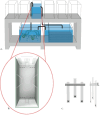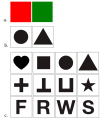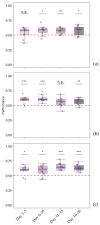Visual Discrimination Task in Guppies Using a Simultaneous Matching-to-Sample Procedure
- PMID: 40646836
- PMCID: PMC12248816
- DOI: 10.3390/ani15131936
Visual Discrimination Task in Guppies Using a Simultaneous Matching-to-Sample Procedure
Abstract
Cognitive abilities in fish have been widely demonstrated using experimental protocols commonly adopted with mammals and birds. Only a few studies have tested fish in the simultaneous match-to-sample task (sMTS), and mixed evidence regarding their capacity to solve the task has been reported. Here we investigated whether guppies (Poecilia reticulata) could discriminate stimuli based on their sameness in the sMTS where fish presented with a sample stimulus had to choose which of two simultaneously presented comparison stimuli matched it. We also assessed how performance was influenced by the training set size and stimulus type. Three experiments were conducted using three different sets of stimuli: two colors (red and green), two geometric shapes (circle vs. triangle); and multiple shapes. Performance was analyzed using binomial tests, t-tests, and generalized linear mixed models. The results showed that guppies learned to select the rewarding stimulus in a relatively limited number of trials and were successful in all experiments. Although no effect of the training set size was observed, guppies were more accurate when multiple stimuli were used. These findings support previous evidence suggesting that multiple training stimuli may improve generalization abilities and set the basis for future studies that adopt a delayed version of the task.
Keywords: behavior; cognition; generalization; guppies.
Conflict of interest statement
The authors declare no conflicts of interest.
Figures





Similar articles
-
Signs and symptoms to determine if a patient presenting in primary care or hospital outpatient settings has COVID-19.Cochrane Database Syst Rev. 2022 May 20;5(5):CD013665. doi: 10.1002/14651858.CD013665.pub3. Cochrane Database Syst Rev. 2022. PMID: 35593186 Free PMC article.
-
Cost-effectiveness of using prognostic information to select women with breast cancer for adjuvant systemic therapy.Health Technol Assess. 2006 Sep;10(34):iii-iv, ix-xi, 1-204. doi: 10.3310/hta10340. Health Technol Assess. 2006. PMID: 16959170
-
Comparison of Two Modern Survival Prediction Tools, SORG-MLA and METSSS, in Patients With Symptomatic Long-bone Metastases Who Underwent Local Treatment With Surgery Followed by Radiotherapy and With Radiotherapy Alone.Clin Orthop Relat Res. 2024 Dec 1;482(12):2193-2208. doi: 10.1097/CORR.0000000000003185. Epub 2024 Jul 23. Clin Orthop Relat Res. 2024. PMID: 39051924
-
Diagnostic test accuracy and cost-effectiveness of tests for codeletion of chromosomal arms 1p and 19q in people with glioma.Cochrane Database Syst Rev. 2022 Mar 2;3(3):CD013387. doi: 10.1002/14651858.CD013387.pub2. Cochrane Database Syst Rev. 2022. PMID: 35233774 Free PMC article.
-
[Volume and health outcomes: evidence from systematic reviews and from evaluation of Italian hospital data].Epidemiol Prev. 2013 Mar-Jun;37(2-3 Suppl 2):1-100. Epidemiol Prev. 2013. PMID: 23851286 Italian.
References
Grants and funding
LinkOut - more resources
Full Text Sources

